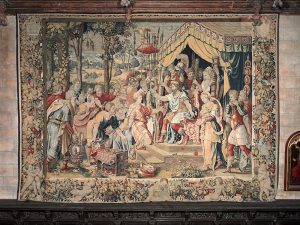Woven on designs attributed to Giulio Romano (Italy, c. 1499 – 1546)
Wool and silk
Brussels, attributed to the workshop of the Dermoyen family, c. 1544 – 1548/55
 Scipio Africanus was a Roman general who defeated Hannibal in the Second Punic War (210 B.C.) Scipio treated the enemies with clemency, allowing them to retain their own legal system. In this scene, the parents of a beautiful young captive have offered to pay for their daughter’s freedom, but Scipio refused to take the ransom. Instead, he releases the young woman to her parents and fiancé, asking only for their allegiance to Rome in return. The tapestry is one of six surviving panels from a set of ten that belonged to Jean d’Albon de Saint-André (1472-1549) and/or Jacques d’Albon de Saint-André (c. 1505/12-1562), members of an aristocratic French family identified by the coats-of-arms in the border. (The four panels at Hearst Castle are the only ones from the original set of ten hangings that survive with their original borders intact.) The tapestries were highly prized for their unusually complex backgrounds, deep perspective into the distance, and variety of dynamic human figures. The set was bought by Cardinal Jules Mazarin and eventually acquired by King Louis XIV. The tapestries remained in the French royal collection until 1797, when they were sold off in the wake of the French Revolution. Moving for more than a century in the art market, the four panels were finally purchased by Hearst and installed in the Assembly Room, which was designed in part specifically to display them. We thank Charissa Bremer-David (J. Paul Getty Museum) for her extensive research on these tapestries.
Scipio Africanus was a Roman general who defeated Hannibal in the Second Punic War (210 B.C.) Scipio treated the enemies with clemency, allowing them to retain their own legal system. In this scene, the parents of a beautiful young captive have offered to pay for their daughter’s freedom, but Scipio refused to take the ransom. Instead, he releases the young woman to her parents and fiancé, asking only for their allegiance to Rome in return. The tapestry is one of six surviving panels from a set of ten that belonged to Jean d’Albon de Saint-André (1472-1549) and/or Jacques d’Albon de Saint-André (c. 1505/12-1562), members of an aristocratic French family identified by the coats-of-arms in the border. (The four panels at Hearst Castle are the only ones from the original set of ten hangings that survive with their original borders intact.) The tapestries were highly prized for their unusually complex backgrounds, deep perspective into the distance, and variety of dynamic human figures. The set was bought by Cardinal Jules Mazarin and eventually acquired by King Louis XIV. The tapestries remained in the French royal collection until 1797, when they were sold off in the wake of the French Revolution. Moving for more than a century in the art market, the four panels were finally purchased by Hearst and installed in the Assembly Room, which was designed in part specifically to display them. We thank Charissa Bremer-David (J. Paul Getty Museum) for her extensive research on these tapestries.


